Magento Inventory Management: The All-In-One Definitive Guide
The term “inventory management” refers to the method used to keep track of multiple stocks. It’s a crucial step in managing the entire supply chain, and it ensures that physical or virtual products keep moving from the factory to the Magento shop and then to the end user.
So, if you want to build an eCommerce website with Magento inventory management and are looking for Magento developers from India, then below is the informative guide you must read before hiring.
1. What is Magento Inventory Management?
In Magento 2.3.x and later, the Magento inventory management extension is automatically installed. It offers MSI support, allowing you to manage inventories and supplies across different sales channels. Tracking the products that come and exit from a store or warehouse is an essential part of advanced inventory management. The specifics of inventory management features may vary from company to company, depending on various factors like size and business style, but the fundamentals always hold true.
Magento’s fundamental APIs for inventory management module is a direct replacement for those of Magento Open Source’s CatalogInventory module and Adobe Commerce’s ScalableInventory module. It also adds new application programming interfaces (APIs) that may be used to customize and expand existing features.
The inventory management tools in Magento allow you to do the following:
- Takes care of inventory from a variety of different places.
- Connects stock from multiple warehouses to various outlets.
- Makes mass changes, such as allocating stock and sources.
- Sets low-stock alert to be triggered when available quantities fall below crucial levels.
- Uses the Source Selection Algorithm to computerize overall stock control.
In Magento 2, stock management is built on top of the Source Selection Algorithm (SSA). It runs invisibly in the background, keeping tabs on items and suppliers to ensure that stock levels are always accurate, conflicts at checkout are avoided, and optimal custom shipping methods are suggested for each transaction.
That’s significant since sometimes it is difficult to keep a track of orders when selling through many mediums at once. Without automation, it is extremely difficult to keep track of inventory and shipping alternatives in real-time.
These actions are carried out by SSA when a consumer orders a customizable product or any other product that has a weight associated with it.
- Verifies the order distribution channel.
- Make sure there is enough supply to meet demand.
- Provides suggestions for low-priced delivery methods.
Following SSA’s advice, you can dispatch the order in many installments, from a single supplier or from a combination of suppliers.
It is important to note that SSA acts differently for digital or virtual products because they do not incur shipping costs. When a consumer places an order for a digital or download product, SSA immediately employs the optimal outcome based on its computations.
Priority algorithms are used by the SSA in inventory management and freight logistics. It also allows you to incorporate algorithms of your own design to better serve your company.
2. Why is Inventory Management So Important?
Successful online store owners understand that proper inventory management may prevent a lot of headaches.
To begin with, it helps to enhance a store’s consumer experience by reducing the likelihood of out-of-stock situations and increasing the availability of items.
Cash flow is improved and fulfillment is optimized so that things are properly placed, kept and shipped out to consumers as soon as possible.
Here are a few key areas where inventory management may shine:
When to order your next shipment: The most obvious benefit of inventory management is to have an exact idea of when to place your next shipping order. When selling a certain item, it’s important to know when to place restocking orders. Management of stock levels allows you to prioritize goods that move off the shelves more quickly than others.
What to order in the future: Choosing what to buy in the future might be difficult, as fads and trends in the market are always changing. It seems like every day; there’s a new product that’s outselling everything else, only to be completely forgotten the day after. In the realm of online retail, this is much more pronounced. The key to staying ahead of the curve is meticulously tracking your Magento stock, so you know exactly what to purchase to meet consumer demand.
How much more to order: Having a limited supply of a product does not always indicate its high demand. How long did it take you to sell 12 items? A week? A month? To save money and time, inventory management may help you anticipate how many items will sell in a certain time frame so you can stock up when necessary and hold off on purchases when they aren’t necessary.
3. Inventory Management Techniques
Effective inventory management practices are essential for any online retailer that wants to ensure on-time product and service delivery of their goods. Managing inventory is an ongoing activity that is crucial to reduce expenses and increase a company’s ability to provide its services at a reduced price.
Here are several methods of stock management employed by Magento-based online stores.
3.1 First In First Out (FIFO)
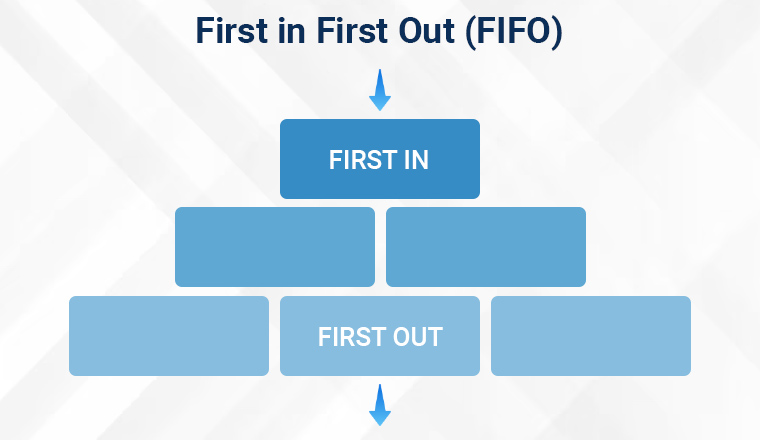
Under the principle of “First In, First Out,” purchases are executed in the sequence in which they were received. Most commonly, FIFO is implemented in the food industry, where fragile goods cannot be held past their sell-by date. This method guarantees that goods are moved quickly through the warehouse.
3.2 Just in Time (JIT)
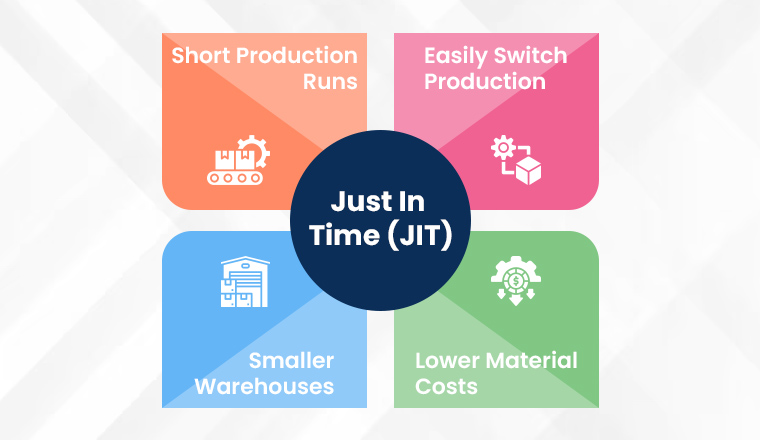
The below image shows how Just in Time inventory technique works,
With the Just-In-Time method, products are shipped or stocked at the same moment an order is placed by a client or when it is anticipated that an order will be placed. This means that the quantity of stock is almost identical to the demand.
In this method, the company only deals with the items that consumers have purchased or are likely to buy in the near term. A key aspect of this strategy is that goods are not kept in the company’s warehouse. Therefore, the warehouse has a lot of empty space, which reduces storage expenses. In addition, the company spends far less money on things like specialized storage space and inventory management.
In order to successfully use JIT, in-depth knowledge of the client’s purchasing patterns is required. This allows for timely order fulfillment by strategically scheduling product deliveries.
3.3 ABC Analysis
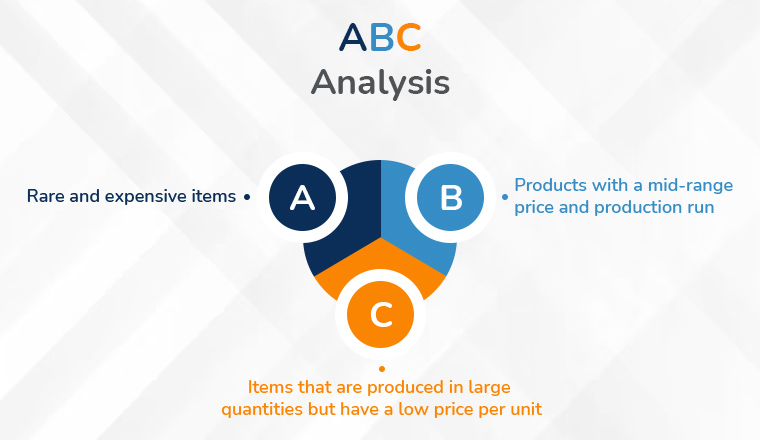
In this method of inventory management, products or items are divided into three groups according to a set of criteria. As name shows, Selective Inventory Control is typically employed by companies that deal with a wide variety of product types.
- A: Rare and expensive items
- B: Products with a mid-range price and production run
- C: Items that are produced in large quantities but have a low price per unit
Products’ classifications might shift as a result of new information or improved performance. Umbrellas, for instance, may fall under Category B during the summer months but move up to Category A during the monsoons and winter months due to its increased demand.
Both JIT and ABC Analysis have similarities that both of them rely on accurate data on customer purchase habits.
3.4 Demand Forecasting
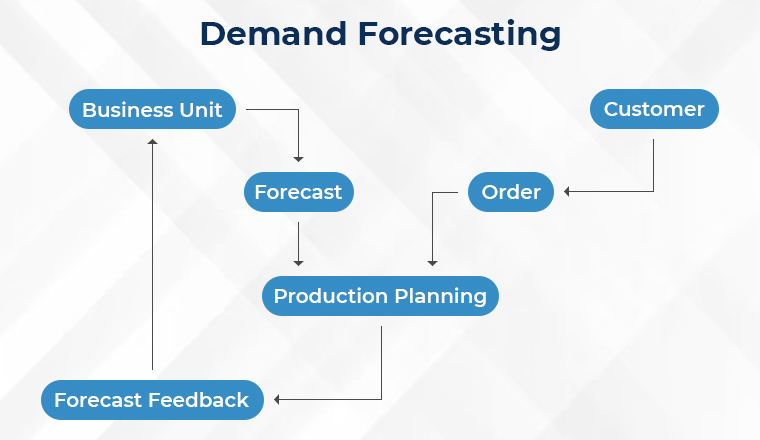
The accuracy of inventory management relies heavily on demand forecasting, a crucial business function. Predicting future stock fluctuations requires a lot of data, but it pays off in the form of useful suggestions.
Predictive models can’t be constructed without historical inventory information. Market volatility, innovative goods, and consumer tastes all pose challenges to the reliability of such predictions. These predictions (using historical data) might aid firms in avoiding inventory-related issues, as the trends of prior years may be repeated.
3.5 Dropshipping
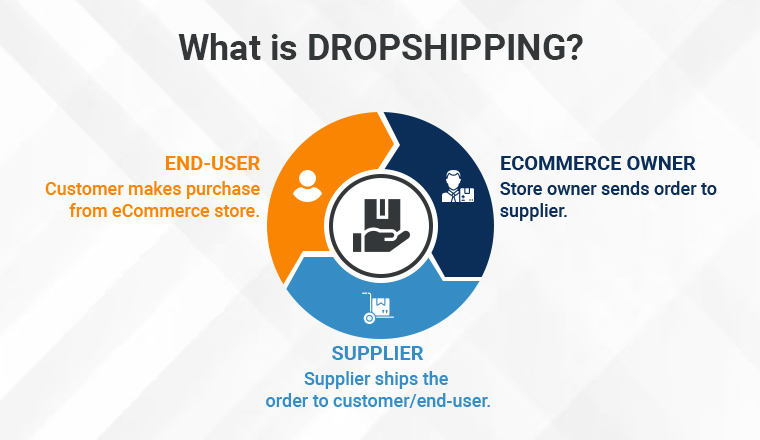
Dropshipping is widely known as an e-commerce approach that doesn’t need warehousing or a specialized inventory. Here, the goods are sent straight from the factory to the buyer. This eliminates the need for the company to set aside funds for warehousing or other related expenses.
For the drop-shipping concept to work, open lines of communication are essential. Delivery is handled by a third party, therefore all communications must go via the right channels to ensure that things arrive on time.
4. Top 5 Magento Inventory Management Tools to Use
If you’re using Magento 2 inventory management tools, you may make use of a variety of helpful features and B2B extensions to expand your company. To help you manage your Magento inventory, we’ve compiled a list of the five best tools available.
4.1 Inventory Management by Magestore
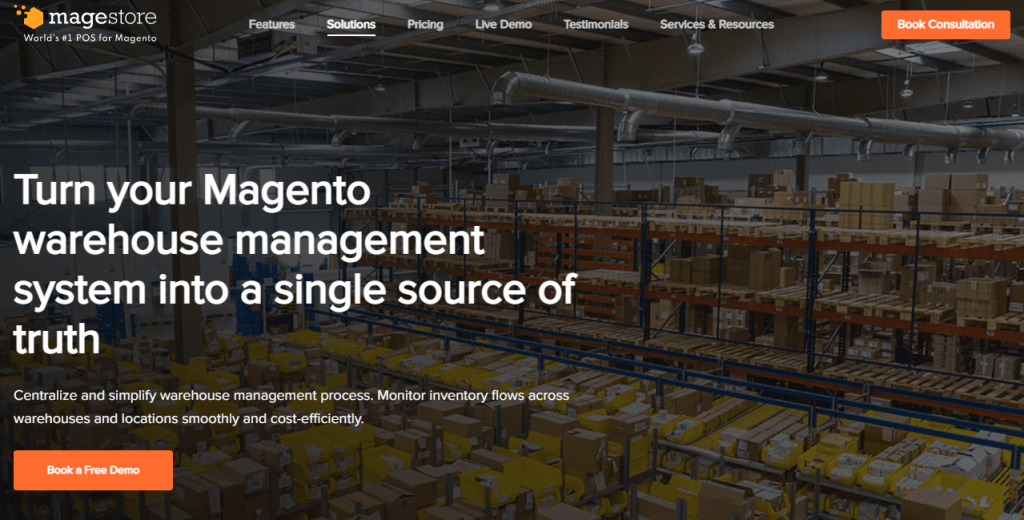
Magestore’s inventory management tool lets you synchronize product data across all of your sales channels in one simple step. It helps in eliminating data entry mistakes and making it easier to keep track of stock across multiple locations.
Profit tracking, identifying top-selling products, and modifying the user interface and user experience are some of the finest inventory management features to set your company apart from the competition. An inventory API can also be used to integrate with third-party applications.
Key Features:
- Distribution stock sync across all sales channels and physical locations in real-time.
- Reading barcodes to keep track of stock.
- The acceptance of purchase orders.
Pricing: Packages begin at $599.
4.2 SkuNexus
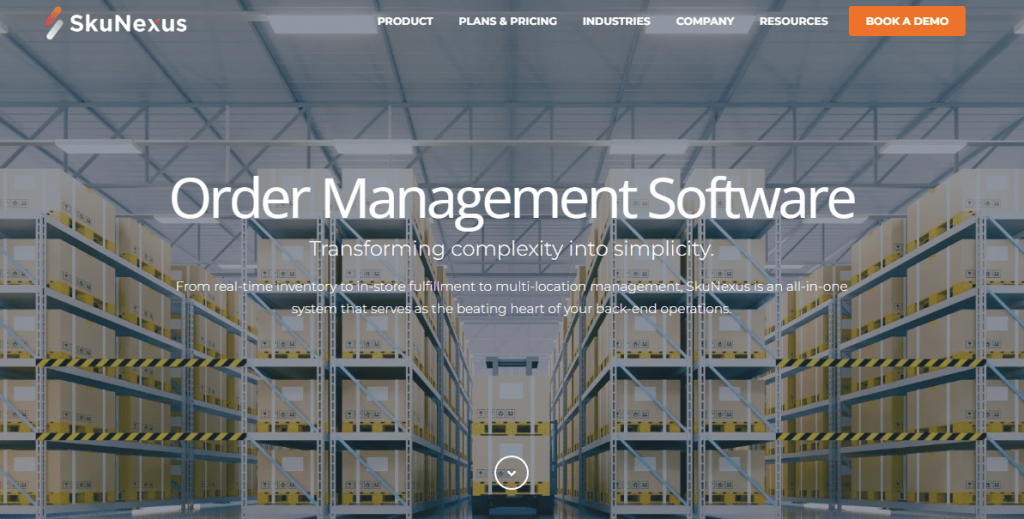
SkuNexus is a unified platform for managing stock in multiple locations, fulfilling orders in-store, and more. It connects seamlessly with over 150 different shopping carts and shipping providers, including Magento.
Key Features:
- Management of orders across many sales channels is automated.
- Automation of fulfillment through bespoke processes.
- Reports on stock levels and expected restocking times.
Pricing: Begin at $299 per month.
4.3 Multi Warehouse Inventory Amasty
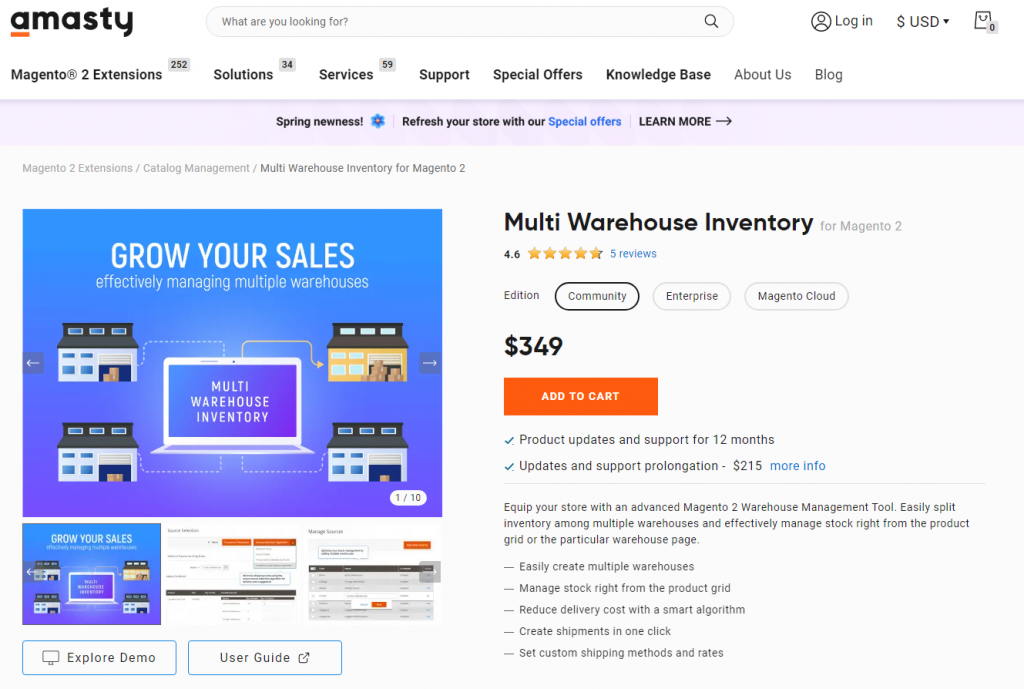
Amasty’s Multi Warehouse Inventory lets you keep tabs on stock from several warehouses. Adding and coordinating an infinite number of storage facilities is a breeze. In addition to standard functionality of an inventory management software, this add-on lets you connect several inventory sources to a single sales channel.
It works with existing MSI algorithms and adds a whole new one that integrates them to provide source selection according to the inventory costs. This add-on also gives you the flexibility to use your own shipping prices rather than the predetermined costs offered by a given shipping service.
Additionally, you may utilize this tool to make mass changes to your product catalog.
Key Features:
- Easily create shipments with only a click.
- One-of-a-kind delivery options and costs.
- Sources are chosen automatically.
Pricing: Begin at $349 per year.
4.4 Multi Warehouse Inventory by Aitoc
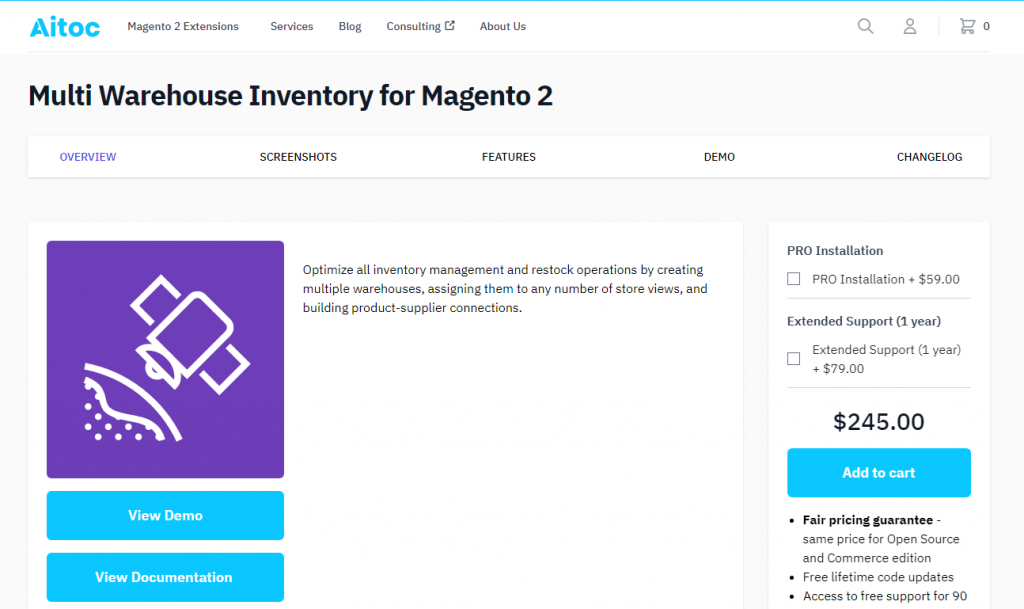
Aitoc’s Multi Warehouse Inventory allows you to track many storage facilities, and on the payment page, it suggests the one that has the nearest address to the ecommerce customer. This saves both time and money.
This add-on comes with a simple-to-use interface that allows you to set up as many storage facilities as you want with no effort. Rather than having to switch between tabs, you can see all of your web store’s warehouses and suppliers on one grid and manage them independently while still having easy accessibility to the rest of the system.
Using this feature, you may divide inventory over many storage facilities while keeping tabs on product availability in real-time.
It also allows for the establishment of location-based and other warehouse selection rules.
Key Features:
- Control over an infinite warehouse.
- Segregating store inventory perspective and client segments.
- Storage facility pick-up and email alerts can be programmed automatically.
Pricing: $299
4.5 Brightpearl by Sage

Enterprise resource planning (ERP) software Brightpearl by Sage includes robust capabilities for managing Magento’s stock. In addition to facilitating data-driven inventory planning, it also provides the time-saving automation features necessary to expedite reordering.
Key Features:
- In-situ stock-taking and accounting.
- Managing stock across many sales channels.
- Strong analytics to manage stock levels and superior prediction tools.
Pricing: Free upon inquiry.
5. Final Thoughts
A thriving online store relies on low overhead expenses, accurate forecasts of future sales, and judicious use of inventory. What’s more, it helps guarantee that your company’s resources aren’t being held hostage by obsolete inventory.
Salsify’s research shows that 91 % of American consumers worry about delivery times and stock levels. By keeping items in stock at all times, an effective Magento inventory management solution will help you avoid such problems and provide a more relaxing shopping experience for your customers.
However, stock levels aren’t the only thing that makes a difference to customers but having safe and quickly loading Magento store is also essential.

Hardik Dhanani has a strong technical proficiency and domain expertise which comes by managing multiple development projects of clients from different demographics. Hardik helps clients gain added-advantage over compliance and technological trends. He is one of the core members of the technical analysis team.
In today's time where the acceptance of online stores has increased and more & more businesses have started coming on digital platforms to sell their...
 Mar 1, 2023
Mar 1, 2023 



Worth reading your blog. I just love the way you demonstrated each and everything related to Magento inventory management. I have been searching for this type of resource for a while.
Thank you for giving such an informative topic. I'm a regular reader of your technical blogs and admire your content writing skills. Continue to post!